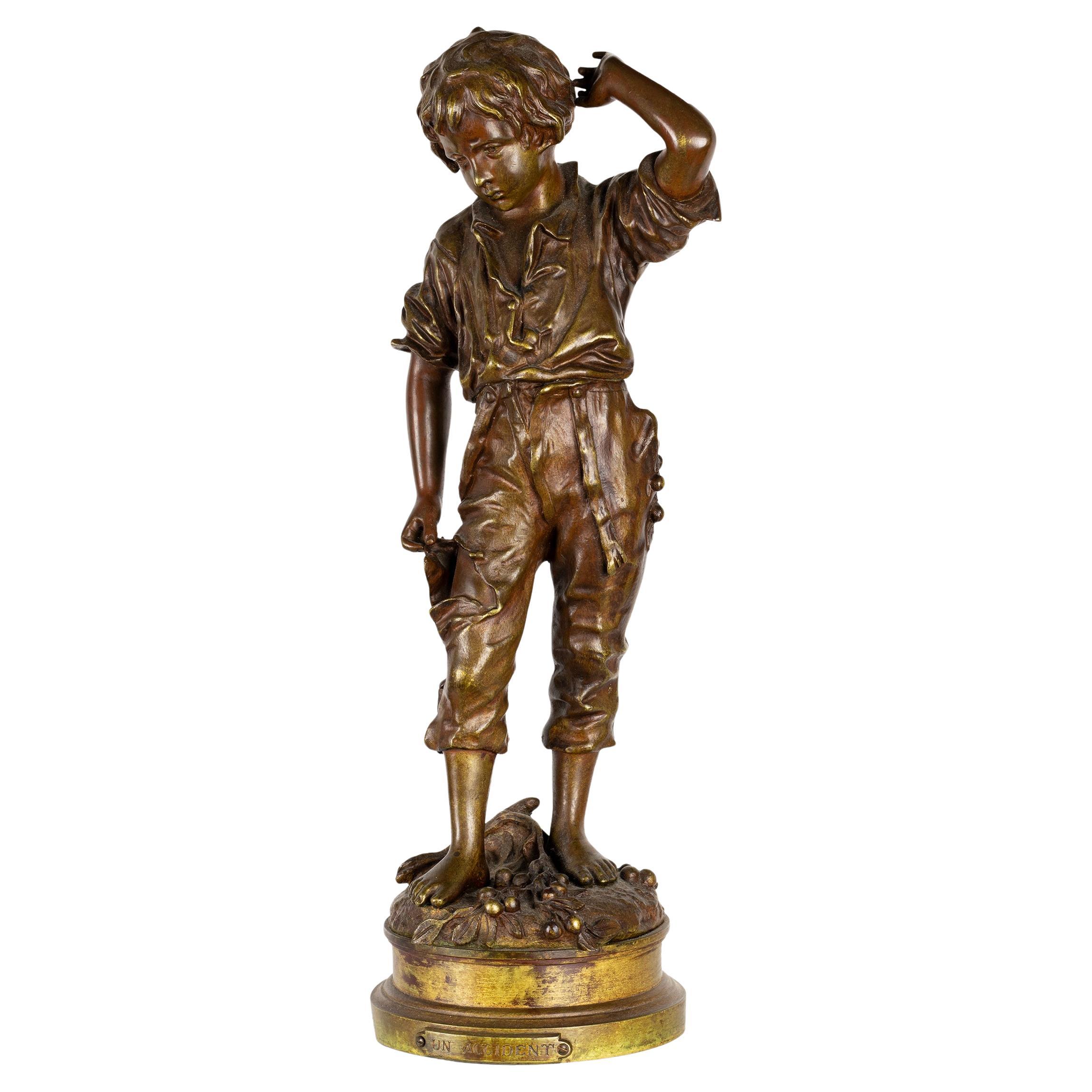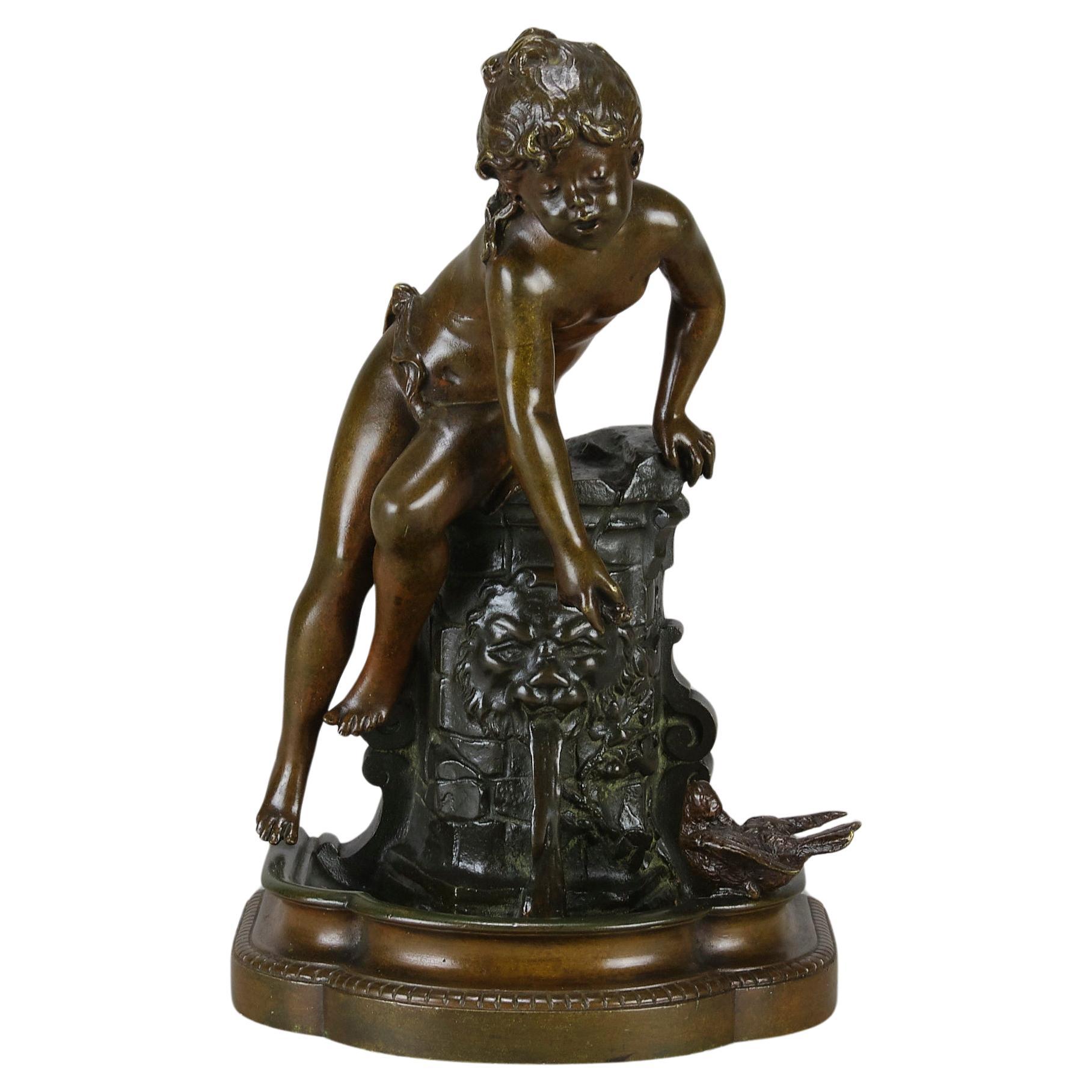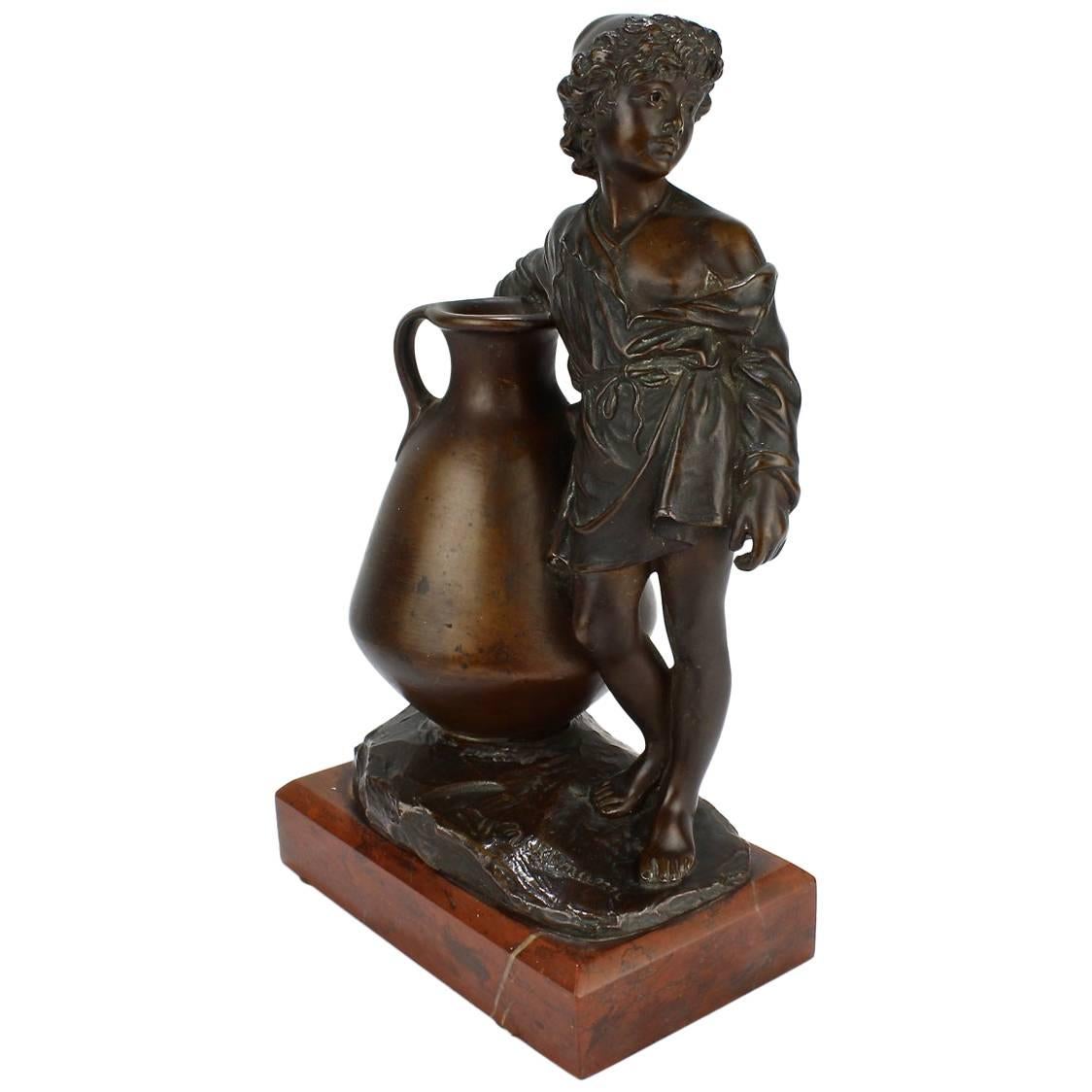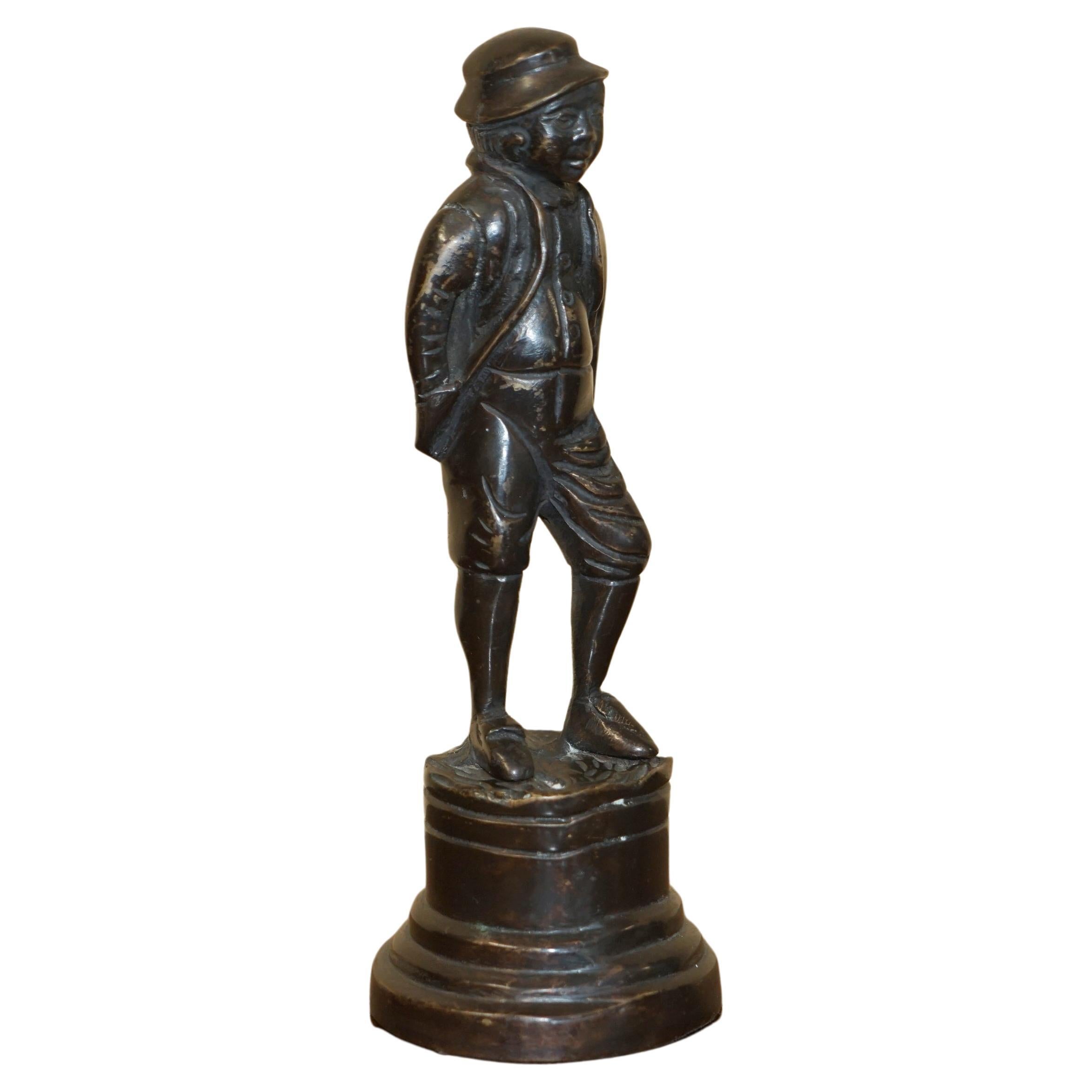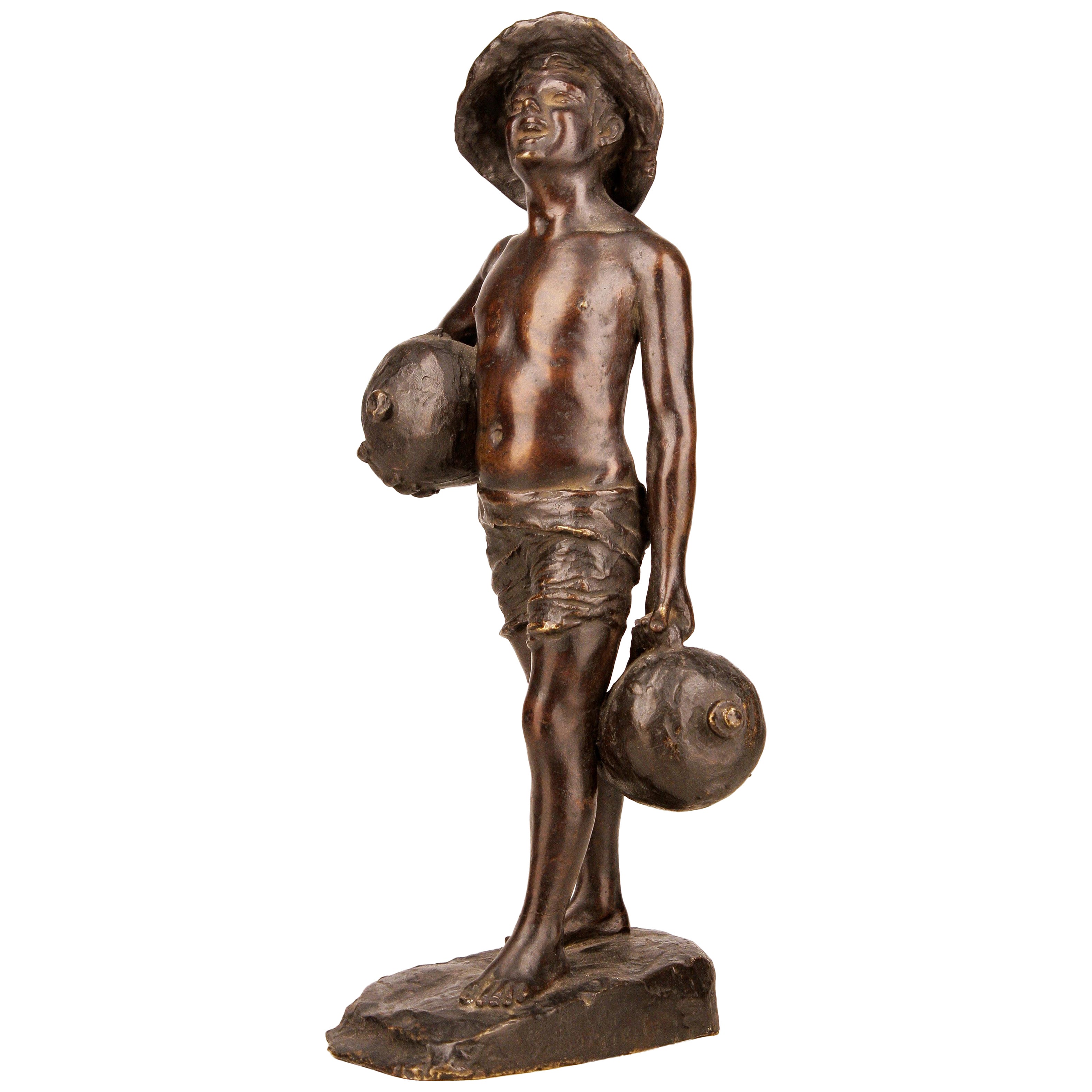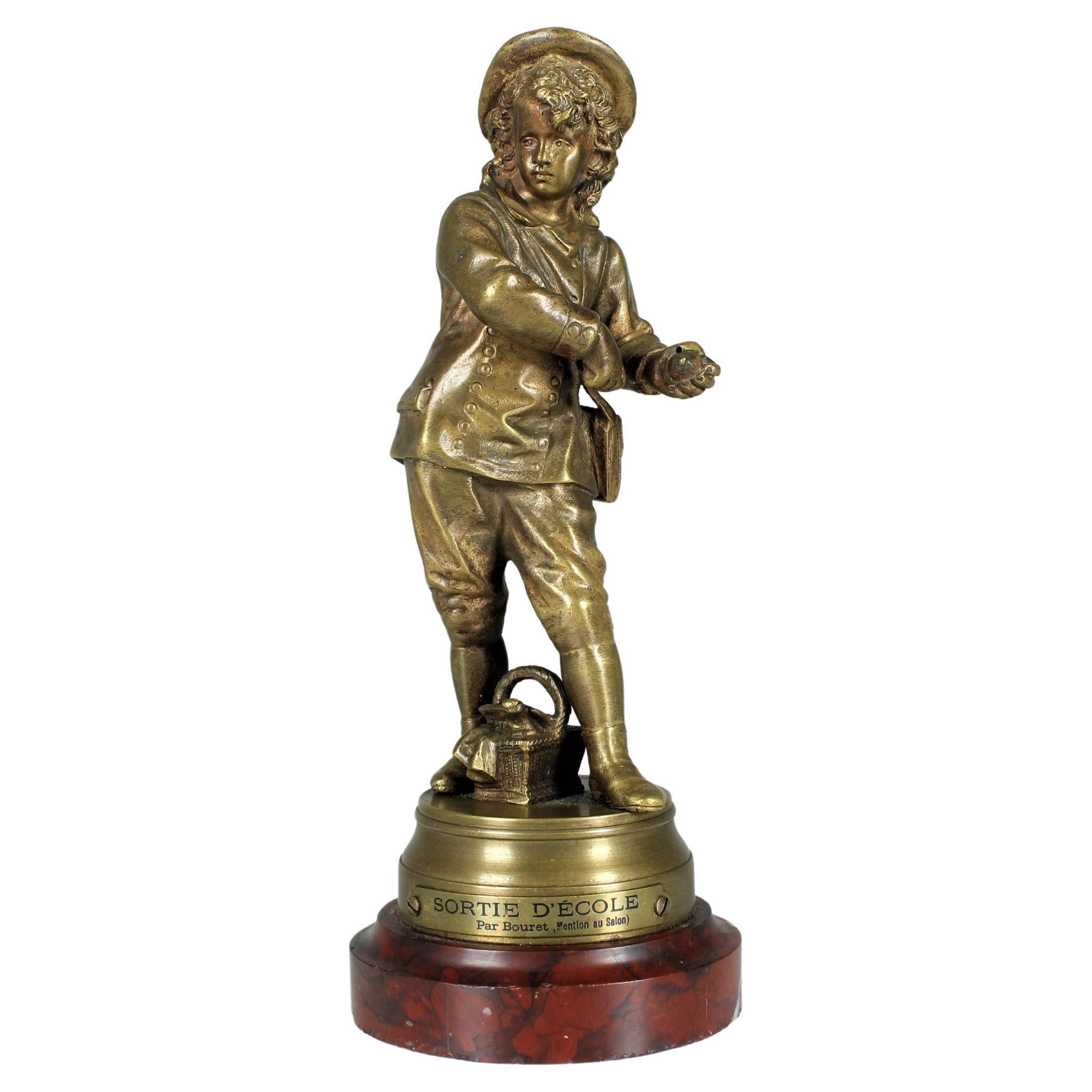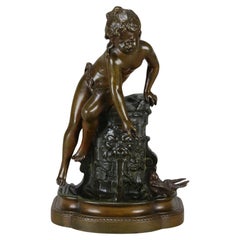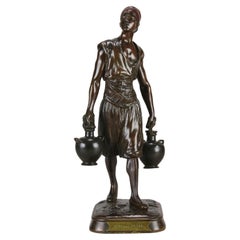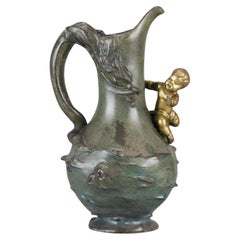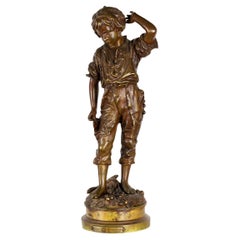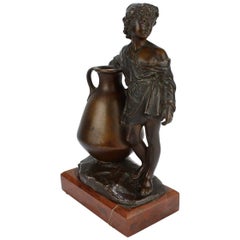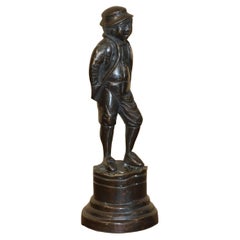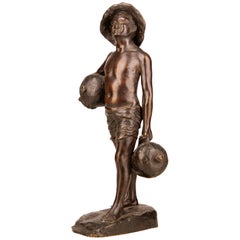Items Similar to Late 19th Century Art Nouveau Bronze Entitled "Broken Jug" by Charles Anfrie
Want more images or videos?
Request additional images or videos from the seller
1 of 12
Late 19th Century Art Nouveau Bronze Entitled "Broken Jug" by Charles Anfrie
$1,505.98
£1,100
€1,291.34
CA$2,112.87
A$2,321.44
CHF 1,197.15
MX$27,813.19
NOK 15,200.14
SEK 14,264.71
DKK 9,644.47
About the Item
A very fine late 19th century bronze figure of a young lad dressed in period attire holding a broken jug, with excellent rich brown patina and fabulous hand finished surface detail, signed & titled
ADDITIONAL INFORMATION
Height: 20 cm
Condition: excellent original condition
Circa: 1890
Materials: Bronze
SKU: 8279
ABOUT
Charles Anfrie (French, 1833 ~ 1905) was a French artist specialising mainly in the human form.
- Creator:Charles Anfrie (Artist)
- Dimensions:Height: 7.88 in (20 cm)Width: 0 in (0.01 mm)Depth: 0 in (0.01 mm)
- Style:Art Nouveau (Of the Period)
- Materials and Techniques:Bronze,Cast
- Place of Origin:
- Period:
- Date of Manufacture:1890
- Condition:Wear consistent with age and use. Excellent. Excellent Original Condition Please note that our items are genuine antiques with considerable age. It is therefore normal that they will show some signs of wear and handling to the surface.
- Seller Location:London, GB
- Reference Number:Seller: 82791stDibs: LU3216329092482
About the Seller
5.0
Vetted Professional Seller
Every seller passes strict standards for authenticity and reliability
Established in 1936
1stDibs seller since 2017
86 sales on 1stDibs
Typical response time: <1 hour
- ShippingRetrieving quote...Shipping from: London, United Kingdom
- Return Policy
Authenticity Guarantee
In the unlikely event there’s an issue with an item’s authenticity, contact us within 1 year for a full refund. DetailsMoney-Back Guarantee
If your item is not as described, is damaged in transit, or does not arrive, contact us within 7 days for a full refund. Details24-Hour Cancellation
You have a 24-hour grace period in which to reconsider your purchase, with no questions asked.Vetted Professional Sellers
Our world-class sellers must adhere to strict standards for service and quality, maintaining the integrity of our listings.Price-Match Guarantee
If you find that a seller listed the same item for a lower price elsewhere, we’ll match it.Trusted Global Delivery
Our best-in-class carrier network provides specialized shipping options worldwide, including custom delivery.More From This Seller
View All19th Century Art Nouveau Bronze Sculpture "Fille au Puits" by Auguste Moreau
By Auguste Moreau
Located in London, GB
A very fine late 19th Century Art Nouveau bronze figure of a young girl sat upon a well feeding a small bird, exhibting excellent rich brown variegated patina and very fine hand fini...
Category
Antique Late 19th Century French Art Nouveau Figurative Sculptures
Materials
Bronze
19th Century bronze entitled "Le Porteur d'Eau Tunisien" by Marcel Debut
By Marcel Debut
Located in London, GB
An excellent French late 19th Century bronze sculpture of a Tunisian man carrying two jugs, one on each arm. With good detail and a rich red/brown patina. Raised on top of a fitted bronze base signed 'Debut' and stamped with 'Bronze Garanti' Seal. Also with plaque to the fore inscribed “Prix de Rome”, attesting to this model winning the top prize at the Exhibition in Rome in 1890.
ADDITIONAL INFORMATION
Height: 32 cm
Width: 14 cm
Depth: 12 cm
Condition: Excellent Original Condition
Circa: 1890
Book Ref Bronze of the 19th Century by Pierre Kjellberg
Materials: Bronze
SKU: 8730
ABOUT
Marcel Debut (French, 1865 ~ 1933)
French sculptor, son of the sculptor Jean Didier Debut (1824-1893). He studied under Henri Chapu at the Ecole des Beaux-Arts in Paris. He exhibited at the Paris Salon from 1883 until the outbreak of the First World War.
He is best known for his sculptures of...
Category
Antique Late 19th Century French Art Nouveau Figurative Sculptures
Materials
Bronze
Early 20th Century Art Nouveau Bronze "Putto Jug" by Georges Van De Voorde
By Georges Van De Voorde
Located in London, GB
A charming early 20th Century bronze vase decorated with a dragon appearing from a lake, its body in the of the vase handle and a putto pearing round the corner with excellent colour...
Category
Early 20th Century Belgian Art Nouveau Figurative Sculptures
Materials
Bronze
Late 19th Century Bronze Entitled 'La Verité Meconnue' by Aime-Jules Dalou
By Aimé-Jules Dalou
Located in London, GB
An enigmatic late 19th Century bronze study of a seated female nude leaning on her knees, hiding her face, on integral naturalistic canted rectangular base, signed to one side DALOU above the cracked mirror (facing to the rear), the opposing side marked Susse Fres Edts the rear with Susse Freres pastille flanked by the letters H P and S.
The title of this subject translates as 'The Truth Revealed' and refers to the young woman inconsolable having seen her true reflection in a mirror, which she has dropped and lies broken on the hard floor.
ADDITIONAL INFORMATION
Height: 14 cm
Width: 12 cm
Depth: 8 cm
Condition: Excellent Original Condition
Circa: 1890
Foundry: Susse Frères Paris
Materials: Bronze
SKU: 8790
ABOUT
Aimé-Jules Dalou...
Category
Antique 19th Century French Art Nouveau Figurative Sculptures
Materials
Bronze
Mid-19th Century French Bronze Entitled "Old Man Odry" by Christophe Fratin
By Christophe Fratin
Located in London, GB
Exquisite mid 19th century French bronze study of an anthropomorphic bear sitting on a barrel playing a violin, the barrel can be opened halfway to form a container. The surface with excellent mid to dark brown patina and very fine hand chased surface detail, signed Fratin and titled Le Père Odry
Additional Information
Height: 17.8 cm
Width: 8.6 cm
Depth: 7.2 cm
Condition: Excellent Original Condition
Circa: 1845
Materials: Bronze
Book reference: Bronzes of the 19th Century by Pierre Kjellberg
About
Le Père Odry
Le Père Odry is a character in one of Balzac's novels, Unconscious Comedians which is one of the lesser known novels in the series La Comédie Humaine. The novel tells the story of a famous painter who takes his provincial cousin on a trip of Paris to open his eyes to what really goes on in the city behind the respectable façade. Le Père Odry appears in the novel as a dissolute actor.
Christopher Fratin, French 1801 ~ 1864
also known as Christophe Fratin, was a noted French sculptor in the animalier style, and one of the earliest French sculptors to portray animals in bronze. Fratin was born in Metz, Moselle, France the son of a taxidermist. He first studied drawing under Pioche in Metz and later worked in Paris at the studio of Théodore Géricault.
He exhibited at the Paris Salon from 1831–1842 and 1850–1862, as well as at the Great Exhibition in London in 1851. Fratin never signed his bronzes but instead used a stamp showing his last name in straight block letters. One of the stamps he used (pictured) showed the "n" reversed, not by design but due to an error on the part of the maker of the stamp. Bronzes bearing this stamp have the appearance of not seeming to be genuine when in reality this foible is actually an indicator of authenticity.
Fratin received monumental commissions in France and elsewhere, including the Deux Aigles Gardant Leur Proie (Eagles and Prey, created 1850) displayed since 1863 in New York City's Central Park. Many of his small bronzes—including his miniature bronzes which were more affordable due to their smaller size—were sold commercially to the general public during his lifetime. Today, Fratin's sculpture is on permanent display in the Louvre, the city museums of Metz, Lyon, Strasbourg, Nîmes and at the Peabody Institute in Baltimore, Maryland. The Georg Eisler...
Category
Antique 19th Century French Art Nouveau Animal Sculptures
Materials
Bronze
Early 20th Century Art Nouveau Bronze Entitled "La Jeuneuse" by Antonin Carlès
By Antonin Carlès
Located in London, GB
A delightful Art Nouveau early 20th Century gilt bronze figure of a very beautiful young lady holding a flower in her right hand, the surface of the bronze exhibiting fine detail and...
Category
Antique Early 1900s French Art Nouveau Figurative Sculptures
Materials
Bronze
You May Also Like
Bronze Boy Sculpture By Charles Anfrie, 19th Century, French
By Vrai Bronze B.D., Charles Anfrie
Located in Lisbon, PT
This 19th-century tabletop bronze sculpture titled Un Accident captures a moment of innocent confusion through the detailed depiction of a barefoot boy in rustic clothing, scratchin...
Category
Antique 19th Century French Napoleon III Figurative Sculptures
Materials
Metal, Bronze
$5,646 Sale Price
20% Off
Antique German Orientalist Bronze Sculpture of a Young Boy with Urn by Uhlmann
By Waldemar Uhlmann, Hermann Gladenbeck
Located in Philadelphia, PA
A good Belle Epoche bronze modeled as a young boy beside a large amphora or vase.
Stylistically informed by Orientalism and various Revival movements active in Europe at the end of the 19th century.
Mounted on a rouge marble base.
Base bears a W. Uhlmann signature in the cast for Waldemar Uhlmann and a Gladenbeck...
Category
Antique Late 19th Century German Revival Figurative Sculptures
Materials
Marble, Bronze
Lovely Bronze Statue of a Victorian Dandy Lovely Rare Find
Located in West Sussex, Pulborough
We are delighted to offer for sale this lovely 21cm tall Victorian Dandy bronze statue with a nice patina.
A very nice piece, I bought this around 20 years ago from a little antiq...
Category
20th Century English Victorian Figurative Sculptures
Materials
Bronze
$520 Sale Price
20% Off
Patinated Bronze Sculpture of Boy Holding Jugs Signed by Italian G. Borriello
Located in North Miami, FL
Patinated bronze sculpture of boy holding jugs signed by italian G. Borriello
By: G. Borriello
Material: copper, bronze, metal
Technique: cast, molded, patinated, metalwork
Dimensio...
Category
Antique Late 19th Century Italian Belle Époque Figurative Sculptures
Materials
Metal, Bronze, Copper
Late 19th Century French Bronze Sculpture, Signed Eutrope Bouret, Sortie D´École
By Eutrope Bouret
Located in Greven, DE
Rare antique bronze by the austrian sculptor Eutrope Bouret (*16.April 1833 in Paris - 1906) on a marble base.
Signed by the arist "Bouret" at the p...
Category
Antique 19th Century French Figurative Sculptures
Materials
Marble, Bronze
Late 19th Century French Patinated Bronze Sculpture of a Peasant/Shepherd Boy
Located in North Miami, FL
Late 19th century french patinated bronze sculpture of a peasant/shepherd boy
By: unknown
Material: bronze, copper, metal
Technique: cast, molded, patinated, metalwork
Dimensions: 6 in x 7 in x 12 in
Date: late 19th century
Style: Romanticism, Naturalism, Realism...
Category
Antique Late 19th Century French Romantic Figurative Sculptures
Materials
Bronze, Metal, Copper
